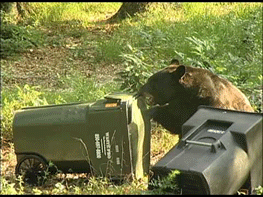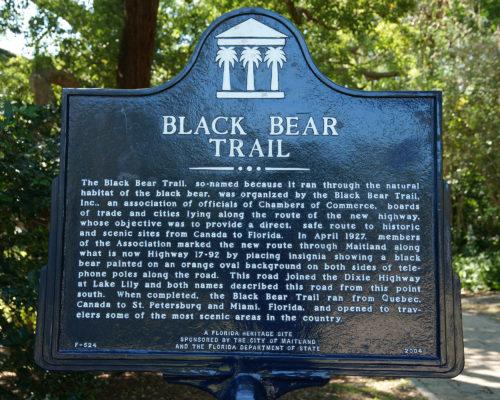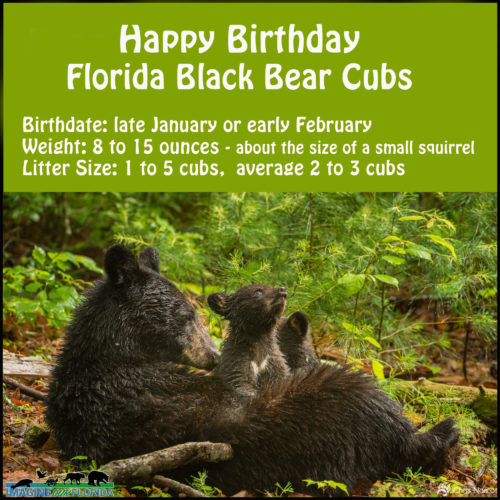URSUS AMERICANUS FLORIDANUS – THE FLORIDA BLACK BEAR – AN UMBRELLA SPECIES
The Florida black bear has captured our hearts and continues to be an inspiration in our efforts to preserve and protect Florida’s natural resources, wildlife, and land. Highly intelligent, charismatic, and majestic, the Florida black bear is an iconic animal, a symbol of our cause and the face of our organization. But besides being a flagship species, the Florida black bear is also an important umbrella species.
The Florida black bear is the largest land mammal in the state, but their size is not the only reason they are called an umbrella species. An umbrella species is one whose habitat encompasses large stretches of land containing many different kinds of plants and animals. Black bears are forest dwellers and require lots of room to roam. Depending on food availability, males can have a home range surpassing 100 square miles, while females can require 25 square miles.
In utilizing large areas of natural habitat, the range of the Florida black bear includes a variety of forest types, including mixed hardwood hammocks, pine flatwoods, sandhills, and sand-pine scrub, as well as forested wetlands. Bears forage for different kinds of food within and between these forest types, depending on the season. Umbrella species require geographically large and diverse areas of natural habitat. These areas are home to many other threatened and endangered animals such as the gopher tortoise, Eastern indigo snake, and the Florida scrub jay. In sharing living space with these other species, the Florida black bear acts like a protective umbrella, ensuring the preservation of various animal and plant species living within those habitats. This biodiversity means a healthy ecosystem for all. Why should we, as humans, care about biodiversity and a healthy ecosystem?
In protecting the bears and their habitat, we are also protecting ourselves. In a fast-paced, technologically advanced society like ours where we are too often far removed from the natural world, this is sometimes hard to remember. Besides being peaceful places for recreation, the forests offer protection of our water sources and help provide cleaner air by breaking down and absorbing pollution. When bears are happy and thriving, all the woodland creatures benefit, including other mammals, reptiles, amphibians, birds, plants, invertebrates, and even fish. But humans also benefit.
With human population growth and development on the rise, healthy habitat for the Florida black bear and the myriad other species under the umbrella decreases. To ensure the continued survival of all these species, it is vitally important to preserve and protect the habitat that remains. Keeping our focus on the protection of the Florida black bear is a good strategy not only because they are strikingly beautiful, but because their well-being is inextricably linked to the health and well-being of so many other species, including humans.
“The Florida black bear historically roamed throughout Florida’s peninsula and southern portions of Georgia, Alabama, and Mississippi (Brady and Maehr 1985). From the 1800s to the 1970s, numbers of Florida black bears were significantly reduced due to loss and fragmentation of habitat and unregulated hunting” (Cory 1896; Hendry et al. 1982).
“We conclude that the loss and fragmentation of once contiguous habitat has caused the loss of genetic variation in the Florida black bear, and that genetic variation in smaller populations is among the lowest reported for all black bears. This substantial loss of genetic variation has contributed to extensive genetic differentiation among populations. Given that Florida black bear populations have been reduced in size, gene flow among bear populations is needed to restore and maintain genetic variation (Waits 1999).
Finally, further reduction or fragmentation of habitat will likely have a detrimental impact on the demographic and genetic health of the Florida black bear populations, and efforts to conserve remaining habitat cannot be overemphasized.” Source: http://www.wec.ufl.edu/faculty/olim/Dixon%20et%20al%20%202007ConservationGenetics.pdf
Source: University of Florida: http://franklin.ifas.ufl.edu/blog/2014/04/25/our-recovering-florida-black-bear-population/
For 21 years, Florida black bears were protected from hunting, and their numbers increased. However, in 2012 the Florida Black Bear was removed from the Florida state list of threatened species.
Although classified as carnivores, the Florida black bear’s diet consists of 80% plant material, 15% insects, and 5% animal matter. A major source of the bear’s diet, saw palmetto berries, has been harvested by humans for years. The berries are sold as herbal supplements. In July 2015, the Florida forest service put a moratorium on permit issuance for the harvesting of saw palmetto berries on state land. Destruction of acorn-producing oak trees is also taking away food from the bears and other wildlife. Trees are being destroyed for timber and to make way for more cattle-grazing land in our state and national forests.
— Florida Black Bear Diet—
Florida black bears are extremely adaptable. Their diet consists of a diverse collection of plants and animals. Here’s a breakdown of what Florida black bear diets have consisted of. When certain foods are out of season or not abundant that year, bears will switch to one of the other food sources available.
66 plants – including smilax, saw palmetto, cabbage palm, scrub palm, needle palm, acorns, various grasses, marlberry, pau pau, hickory, scrub rosemary, holly, crab apples, mulberry, wild coffee, wild cherries and plums, wild blueberries, bromeliads, and lichens.
29 insects- Consist of ants, wasps, yellow jackets, beetles, weevils, walking sticks, grasshoppers, and flies.
3 arthropods- ticks, crayfish, and centipedes.
13 vertebrates- including birds, armadillo, opossum, turtles, rabbit, alligator eggs, raccoons, and deer. (Maehr and Brady).
This is just a shortlist. In some areas, bears have become accustomed to anthropogenic food supplies. One study referenced the Lake Wales Ridge, which has been vulnerable to development. Bears in this area adapted by consuming garbage and citrus fruit ( Murphy et al. 2017). Other studies identified dominant foods by both region and season (Stratman 1998; Dobey 2005). These foods might be the most preferable, but they aren’t the only foods available.
References:
Dobey S, Masters DV, Scheick BK, Clark JD, Pelton MR, Sunquist ME. 2005. Ecology of Florida black bears in the Okefenokee-Osceola ecosystem. Wildlife Monographs 158(1):1-41.
Maehr DS and Brady JR. 1984. Food habits of Florida black bears. The Journal of Wildlife Management 48(1):230-5.
Sean M. Murphy, Wade A. Ulrey, Joseph M. Guthrie, David S. Maehr, Warren G. Abrahamson, Sutton C. Maehr, John J. Cox. 2017. Food habits of a small Florida black bear population in an endangered ecosystem. Ursus 28(1):92-104.
Stratman R. M., 1998. Habitat use and effects of prescribed fire on black bears in northwestern Florida. University of Tennessee, Knoxville.
 Longleaf Pine Rock Springs Run ©IOF
Longleaf Pine Rock Springs Run ©IOF
In the absence of human influence and when only natural food sources are available, a bear population will not outgrow its food sources. If food is scarce, bears will have fewer, and in some cases, no cubs.
In preparation for denning in the winter, bears can consume more than 20,000 calories per day. When natural food sources are poor, bears must search for food, often traveling many miles, which unfortunately puts them in danger of encounters with humans. Human carelessness, such as leaving trash, pet food, birdseed, and dirty barbecue grills outside or in screened-in porches, draws bears into neighborhoods for a quick meal. Often this results in relocation or worse. When a bear is deemed a “nuisance,” he/she is killed.
©TheBearSmartSociety
The perceived threat of bears hurting humans is based on irrational fear. There is no documented case of a human being killed by a Florida black bear…EVER! However, humans kill an alarming number of black bears, even excluding legal hunting. Roadkill numbered 243 bears in 2015.
600lb+ Roadkill ©IOF
There are seven Bear Management Units (BMUs) in Florida, each representing a distinct subpopulation of the subspecies of Florida black bear. 
Source: http://myfwc.com/hunting/by-species/bear/rules/
BEAR HUNT 2015
An estimated 75% of Florida residents who voiced their opinion were opposed to the bear hunt. This included phone calls, letters, and emails to the governor, FWC, and other lawmakers.
3,778 permits were sold to hunt only 320 Florida black bears, more permits than bears in the state of Florida. Since bears had not been hunted in 21 years, they were trusting and naïve, a recipe for disaster.
There were 28 lactating females killed during the bear hunt of 2015. With 1 to 4 cubs born to each mother, that means that an average of 70 cubs were left orphaned. Bear cubs remain with their mother for up to 18 months. With most cubs born in January, these cubs were approximately 9 months old at the time of the October hunt.
The number of bears killed in the hunt was 304. However, that number doesn’t count:
- Bears who may have been injured by hunters ran away and later died.
- Orphaned cubs which may not have survived without their mothers.
- Any bears illegally poached, possibly including a bear cub later found floating in the Suwannee River
While FWC’s target was 20%, including death from means other than hunting, the known death toll was over 21.5% of Florida black bears’ total population. Meanwhile, Florida’s human population continues to grow by more than the entire bear population every week.
Most hunters do not eat the bears they kill, making this a blood sport, thrill kill, and trophy hunt.
Within 13 hours of the hunt, quotas were exceeded in the East Panhandle and Central regions. By the end of the 2nd day, the hunt was called off completely.

There is no science to support the supposition that hunting decreases human-bear conflicts or that bears that habituate to humans are more likely to be aggressive.
Non-lethal solutions exist to prevent human-bear encounters. A 12-month study in a Volusia County neighborhood showed that bear-resistant trash cans reduced such encounters by 95%. Coupled with the preservation of the bears’ natural food sources, providing bear-resistant trash cans in every county within bear country is a compassionate, non-lethal solution to the prevention of human-bear conflict. In 2016, the Florida legislature approved funding to help communities to offset the cost of bear-resistant trash cans. In 2017, bills were sponsored in both the Florida House of Representatives and the Senate, which provide additional money for bear-resistant trash cans and include a 10-year moratorium on bear hunting.







